The Splendor of Chartres Cathedral: A Masterpiece of Gothic Architecture
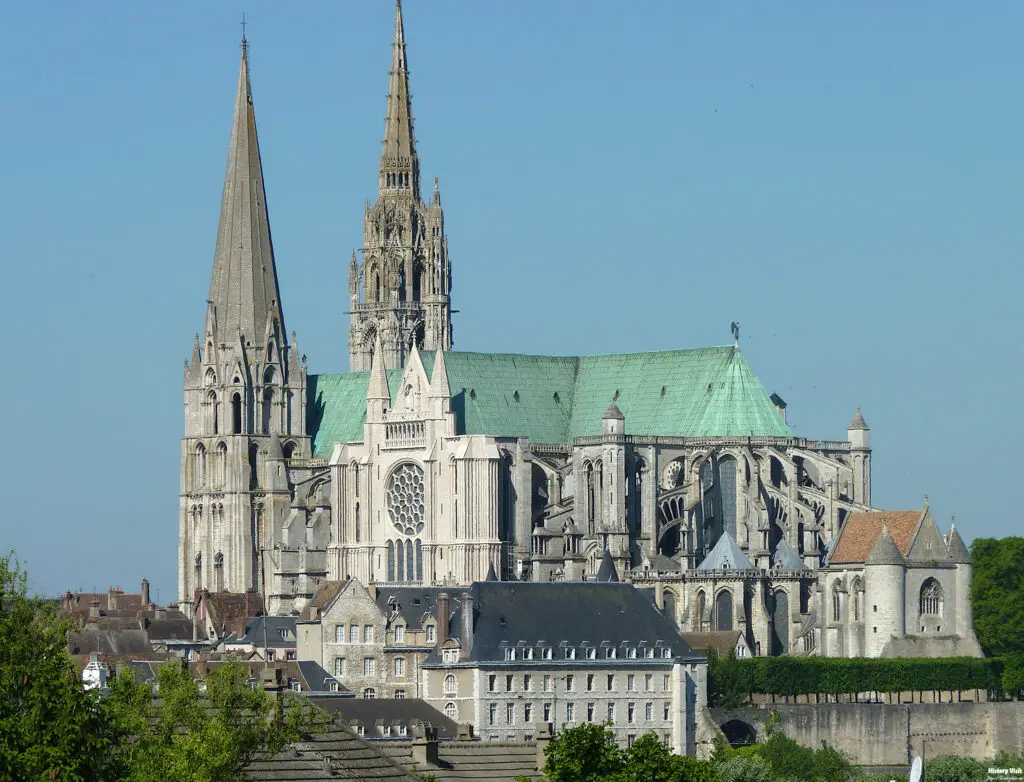
Introduction
Chartres Cathedral, located in the town of Chartres, France, is a paramount example of Gothic architecture. Constructed primarily between 1194 and 1220, this magnificent structure has stood the test of time, remaining one of the most well-preserved medieval cathedrals in Europe. Its architectural grandeur, along with its significant historical and cultural relevance, continues to attract scholars, architects, and tourists from around the world.
The cathedral is not only a remarkable architectural feat but also a symbol of medieval ingenuity and devotion. Its soaring spires, intricate sculptures, and stunning stained glass windows exemplify the heights of artistic and engineering achievement during the Gothic period. Chartres Cathedral has been a site of pilgrimage for centuries, drawing people from all walks of life who come to marvel at its beauty and seek spiritual solace.
In this article, we will explore the historical background, architectural features, stained glass windows, sculptural decorations, religious and cultural importance, restoration efforts, and the contemporary relevance of Chartres Cathedral. Each section delves into different aspects of the cathedral, offering a comprehensive understanding of why Chartres stands out as a masterpiece of Gothic art and architecture.
Historical Background

The origins of Chartres Cathedral date back to the 4th century when a primitive church was first established on the site. However, the current structure’s history begins in earnest in the late 12th century, following a devastating fire in 1194 that destroyed much of the earlier building. This tragedy prompted a major reconstruction effort, resulting in the cathedral we see today.
The construction of the new cathedral commenced almost immediately after the fire, under the guidance of Bishop Renaud de Mousson. It was a monumental project that spanned several decades, incorporating both innovative Gothic elements and traditional Romanesque features. The rapid pace of construction is a testament to the resources and dedication invested in the project by the clergy and the local community.
Throughout its history, Chartres Cathedral has witnessed numerous significant events. It played a crucial role during the Hundred Years’ War, serving as a refuge and a symbol of French resilience. The cathedral also survived the ravages of the French Revolution, although it faced periods of neglect and damage. Despite these challenges, it has remained a central figure in the religious and cultural life of Chartres and beyond.
Architectural Features
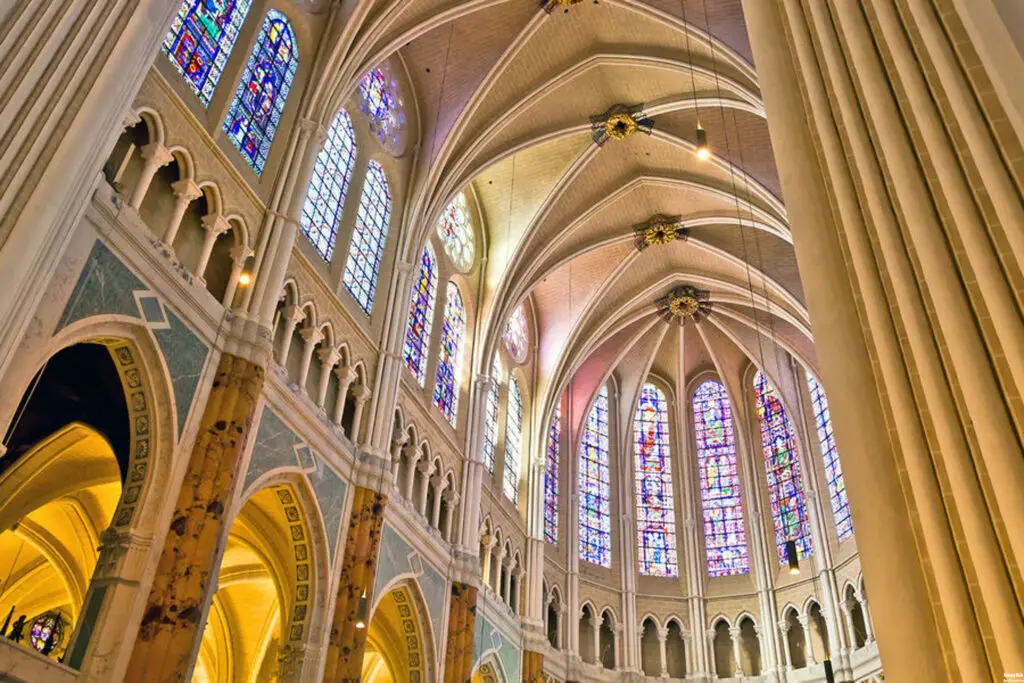
The architectural features of Chartres Cathedral are both innovative and awe-inspiring. The cathedral’s general layout follows the traditional Latin cross plan, with a long nave, transepts, and a choir. The dimensions are impressive, with the nave reaching a length of 130 meters and the height of the main towers exceeding 100 meters. This grand scale contributes to the cathedral’s imposing presence.
One of the most notable architectural innovations of Chartres is the use of flying buttresses. These external supports allowed builders to construct higher walls and larger windows, a hallmark of Gothic architecture. The ribbed vaults, another key feature, provided additional structural stability while creating an intricate ceiling pattern that enhances the interior’s aesthetic appeal.
The cathedral’s facade and towers are also remarkable. The west facade, known as the Royal Portal, is adorned with sculpted figures representing biblical kings and queens, a testament to the detailed craftsmanship of the period. The two towers, though asymmetrical due to differing construction periods, add to the cathedral’s unique silhouette. Inside, the labyrinth embedded in the floor of the nave serves as a symbol of the spiritual journey and is a point of fascination for many visitors.
Stained Glass Windows
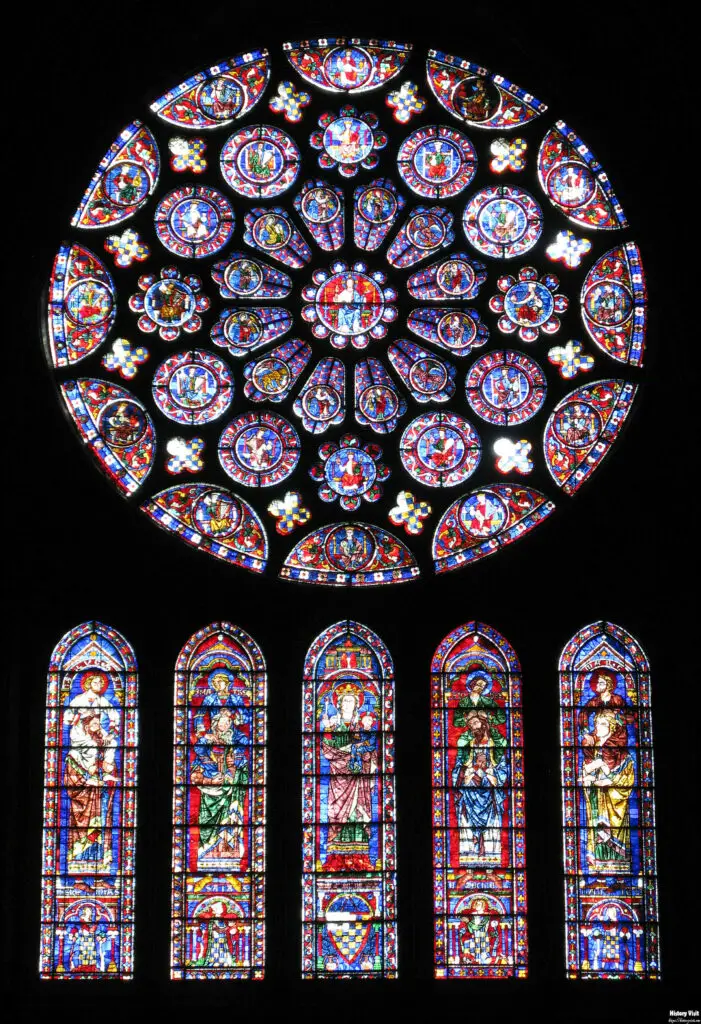
Chartres Cathedral is renowned for its stunning stained glass windows, which are considered some of the finest in the world. These windows, dating primarily from the 12th and 13th centuries, cover an extensive area of the cathedral and depict a wide array of biblical scenes, saints, and symbolic motifs. The vivid colors and intricate designs create a mesmerizing effect as light filters through them, bathing the interior in a kaleidoscope of hues.
The historical context of these stained glass windows is significant. They were created during a period of great religious fervor and were intended to educate and inspire the largely illiterate medieval populace. The windows serve as a visual narrative of the Christian faith, with each pane telling a part of a larger story. Among the most famous is the “Blue Virgin” window, known for its deep, rich blue tones that have become emblematic of Chartres.
Craftsmanship played a crucial role in the creation of these windows. Medieval artisans used techniques that combined various metals with glass to produce the vibrant colors that are still admired today. The windows’ durability and the quality of their preservation speak to the skill and dedication of the craftsmen who made them. Modern conservation efforts continue to ensure that these masterpieces of medieval art remain intact for future generations to appreciate.
Sculptural Decoration
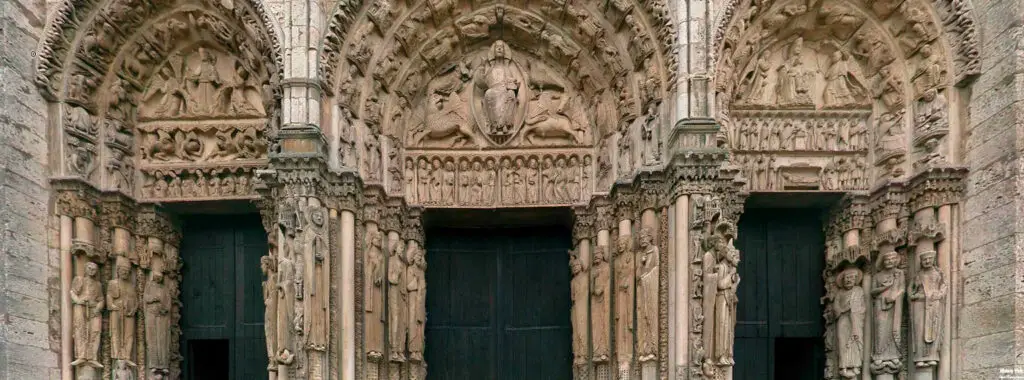
The sculptural decoration of Chartres Cathedral is another aspect that showcases the artistic brilliance of the Gothic era. The exterior of the cathedral is adorned with a plethora of sculptures that serve both decorative and didactic purposes. The portals, particularly the Royal Portal on the west facade, are among the most notable, featuring a rich array of figures and scenes from the Old and New Testaments.
The Royal Portal sculptures are renowned for their expressive quality and detailed craftsmanship. The figures of kings, queens, prophets, and apostles are depicted with a sense of realism and individuality that was innovative for its time. These sculptures not only enhance the cathedral’s aesthetic appeal but also convey complex theological concepts and narratives to the medieval viewer.
Inside the cathedral, the sculptural decorations continue to impress. The choir screen, for example, is a masterpiece of Gothic art, intricately carved with scenes from the life of Christ and the Virgin Mary. These interior sculptures, like their exterior counterparts, are rich in symbolism and serve to reinforce the cathedral’s role as a place of worship and spiritual instruction.
Religious and Cultural Importance
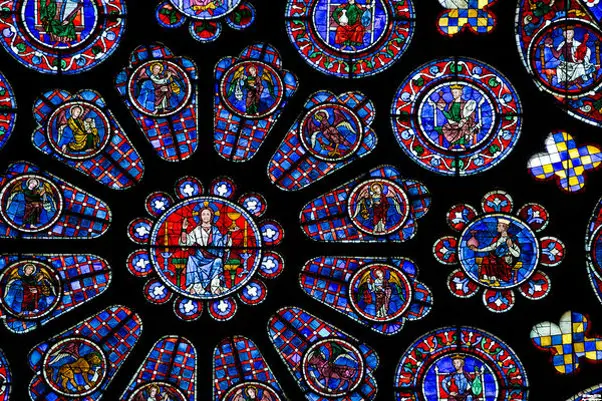
Chartres Cathedral has long been a significant site of pilgrimage, drawing visitors from across Europe and beyond. Its religious importance is underscored by the presence of the Sancta Camisa, a relic believed to be the tunic worn by the Virgin Mary at Christ’s birth. This relic has been a focal point for pilgrims since the Middle Ages, contributing to the cathedral’s status as a major religious destination.
The cathedral’s role in medieval pilgrimage was not just spiritual but also cultural. Pilgrims brought with them stories, traditions, and artistic influences from their regions, enriching the cultural tapestry of Chartres. The influx of visitors also contributed to the local economy, fostering a sense of community and shared identity centered around the cathedral.
Beyond its religious significance, Chartres Cathedral has had a profound impact on Gothic art and architecture. It served as a model for subsequent cathedrals and churches, influencing the design and construction techniques of numerous Gothic structures. The cathedral’s artistic and architectural innovations have left a lasting legacy, making it a key reference point in the study of medieval art and architecture.
Restoration and Preservation
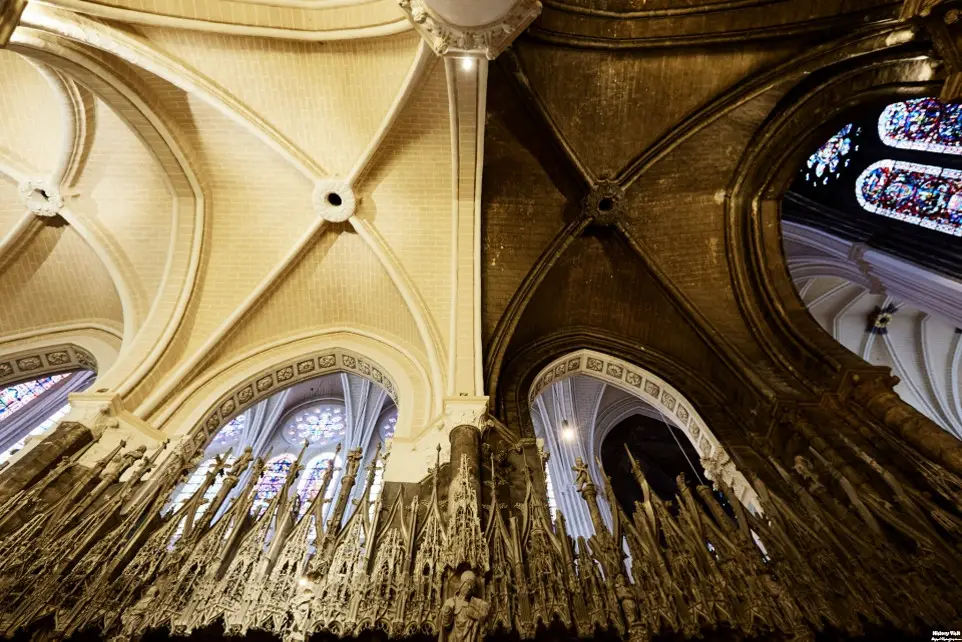
Throughout its history, Chartres Cathedral has undergone various restoration efforts to preserve its structural integrity and artistic treasures. The first major restoration took place in the 19th century, led by the renowned architect Eugène Viollet-le-Duc. His work focused on stabilizing the structure and restoring damaged sculptures and stained glass windows, ensuring that the cathedral could continue to inspire future generations.
Modern preservation efforts face different challenges, including environmental factors, pollution, and the sheer age of the building. Recent projects have aimed to address these issues through meticulous cleaning and conservation techniques. The restoration of the stained glass windows, for example, involves advanced methods to clean and repair the glass while preserving its original colors and designs.
Looking to the future, ongoing conservation plans are essential to maintain Chartres Cathedral’s condition. These efforts require collaboration between experts in various fields, including architecture, art history, and materials science. Funding and public support also play a crucial role in ensuring that this UNESCO World Heritage site remains protected for future generations to admire and study.
Chartres Cathedral Today
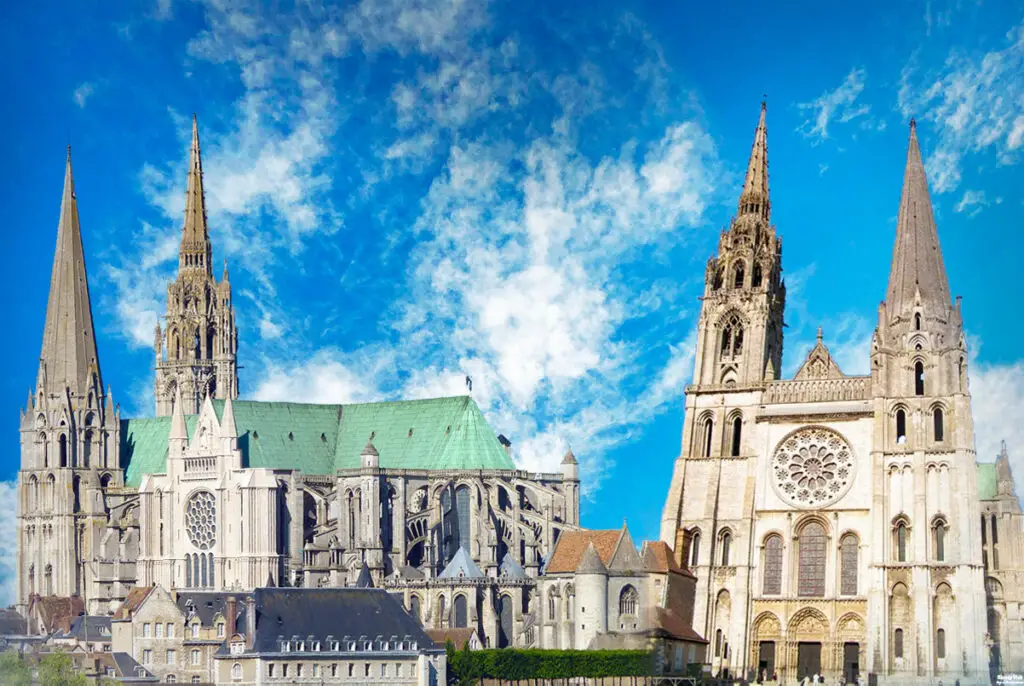
Today, Chartres Cathedral continues to be a major tourist attraction, drawing thousands of visitors each year. Its status as a UNESCO World Heritage site underscores its global significance and helps attract international attention. The cathedral’s majestic architecture and artistic treasures make it a must-see destination for those interested in history, art, and religion.
Despite its popularity as a tourist site, Chartres Cathedral remains an active place of worship. Regular services, including masses and special religious events, are held within its hallowed walls. The cathedral also hosts concerts and cultural events, blending its spiritual functions with its role as a cultural hub.
The impact of Chartres Cathedral on contemporary culture is profound. It serves as a source of inspiration for artists, writers, and scholars, who continue to draw from its rich history and artistic heritage. The cathedral’s enduring presence is a testament to the timeless appeal of Gothic architecture and the enduring power of human creativity and faith.
Conclusion

Chartres Cathedral stands as a testament to the heights of human achievement in architecture, art, and spirituality. Its historical significance, architectural innovations, and artistic treasures make it a unique and invaluable part of our cultural heritage. From its origins in the medieval period to its continued relevance today, the cathedral embodies the enduring legacy of Gothic art and architecture.
The cathedral’s intricate stained glass windows and sculptural decorations not only showcase the skill of medieval artisans but also serve as a visual narrative of the Christian faith. Its role as a pilgrimage site and cultural landmark has shaped the history and identity of Chartres, influencing generations of visitors and scholars.
As we look to the future, the preservation of Chartres Cathedral remains a priority. Ensuring that this architectural masterpiece endures for future generations requires ongoing efforts and support. Chartres Cathedral’s enduring legacy as a symbol of human ingenuity and devotion will continue to inspire and captivate those who behold its splendor.


